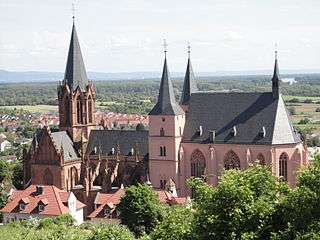Oppenheim
Oppenheim is a city at the Rhine in the state Rhineland-Palatinate in Germany.

Understand
Oppenheim is on the Rhine, in the middle between Mainz and Worms, was granted market rights in 1008, city rights in 1225, and flourished until overrun by Spanish, Swedish and French troops in 1620, 1631 and 1689 respectively. After that it never regained its previous importance and wealth, but remains a charming small city with mediaeval flair, proud of its history and its wine. Particularly the Krötenbrunnen vineyards are sometimes known beyond Germany.
Oppenheim once was home to a small Jewish community, which was scattered by the atrocities before and during WWII. Several families named 'Oppenheim' or 'Oppenheimer' can be found in the USA and other parts of the world.
Get in
By train
Fast trains (ICE, IC, RE) won't stop in Oppenheim. Visitors have to take the slow train (RB, Regionalbahn). 'RB44' runs from Mainz via Oppenheim and Worms to Mannheim (or vice versa) every half an hour during normal hours on work days and once per hour on weekends. If you're coming in from nearby Frankfurt airport then take a train to Mainz first and change there.
From Oppenheim's train station it is only a 5-10 minutes walk to the Old Town. (There is a city map across the street in front of the former station building.)
By car
The B9 state road connects Oppenheim to Mainz and Worms. Just north of the town is the Nierstein car ferry across the Rhine in the direction of Darmstadt. The B420 provides connections from the A61 and A63.
Get around
There is no public transportation (the only buses are school buses), but the city, particularly the Old Town, is so small you can walk everywhere within minutes.
City maps are downloadable from Oppenheim's homepage.

See
- The Old Town with its marketplace and the Town Hall, just below the church.
- 🌍 Saint Catherine’s Church (Katharinenkirche), Katharinen Street 1, ☎ +49 6133 2381. built 1220-1439, often named 'the most outstanding Gothic church on the Rhine between Cologne and Strasbourg'. Most of the stained glass windows are still genuine from the 14th(?) century. Sometimes the church's main tower is open for visitors. If you get a chance, do climb it. The effort of the many stairs is rewarded by a spectacular view of the town.
- The Ossuary (Beinhaus) (immediately behind the church). Bones of 20,000 people neatly stacked are a creepy view .
- 🌍 St Bartholomäus Church (a bit south of the marketplace).
- 🌍 Landskrone Castle (Burg Landskron). Ruin of castle built in the 16th century on the remains of an even older (11th century?) castle, destroyed in 1689. Located at the very top you can get a great view of the town and the surrounding countryside. During summer the ruin is sometimes used for theatre performances. If you walk from the ruin past the Ruprechtsturm downstairs to the Clock Tower (Uhrturm, near the train station) you might notice a huge chunk of curved brickwork (to the left of a small viewing balcony). This is a piece of the castle's round main tower. Despite weighing several tons, it was hurled hundreds of meters when the tower was blown up in 1689.
- 🌍 Gautor (about 100 m south-west of the marketplace). a gate building in the town's old fortifications.
- 🌍 Oppenheimer Kellerlabyrinth (Oppenheim Cellar Maze), Merianstraße 2 (near the marketplace at the street leading up to St Catherine's). under the Old Town, sometimes also called Stadt unter der Stadt (City beneath the city). Spurred by the city's uneasy past and the soft yet sustainable soil, Oppenheim's medieval inhabitants dug at least 40 km worth of tunnels and rooms beneath the 'visible' city. Among other things, the St Catherine's Church's stained glass windows survived here not only several medieval wars but also WWII bombings. A part of the tunnels have been made accessible to the public. Guided tours (in several languages) are offered by the town’s tourism and festival play bureau. The underground rooms also sometimes host theatre performances and other events.
- Town Museum, Merianstr. 4.
- 🌍 German Viticultural Museum (Deutsches Weinbaumuseum), Wormser Str. 49. closed during winter and on Mondays. Showing old methods and tools for wine production. tickets 3 €.
Do
Stroll through the Old Town, enjoy the view from the castle, do a guided underground tour and climb the tower of St Catherine's if you get a chance. Use Oppenheim as a 'base camp' for several beautiful bicycle tours along the river Rhine. However, if you're looking for a wild night life instead, you might have come to the wrong place.
Buy
Various small shops are located in the town center around the marketplace and along 'Mainzer Straße'. For supermarkets look to the south of the town, between Oppenheim and Dienheim.
Eat
- 🌍 Weinhöfchen, Merianstraße 7, ☎ +49 6133 571971.
Drink
Sleep
- 🌍 Merian Hotel, Wormserstr. 2, ☎ +49 6133 94940.
- 🌍 Hotel Gold'ne Krone (Restaurant Stivale), Am Markt 4, ☎ +49 6133 94110.
- There are also a number of holiday apartments to rent; see the town's website.
Connect
- Tourism and festival play bureau, Merianstr. 4, ☎ +49 6133-4909-19, fax: +49 6133-4909-29, e-mail: info@stadt-oppenheim.de.
Go next
- Along the Rhine by bicycle, e.g. to Nierstein, Nackenheim or the Kühkopf island near Guntersblum.
- Nierstein (3 min by train)
- Nackenheim (7 min by train)
- Mainz (20 min by train)
- Worms (20 min by train)
- Frankfurt
- Mannheim (1 hour by (slow) train)
- Darmstadt
- Heidelberg